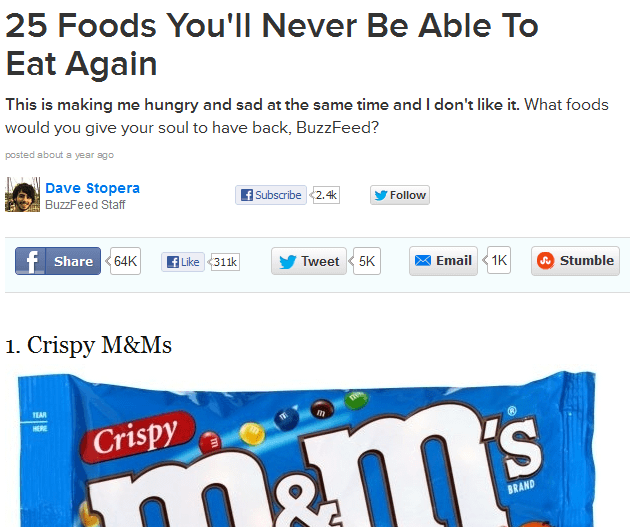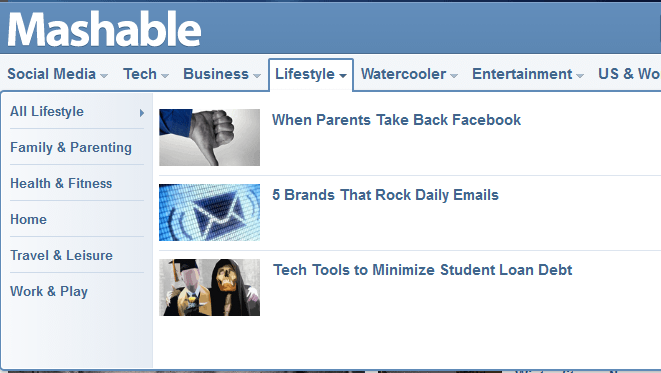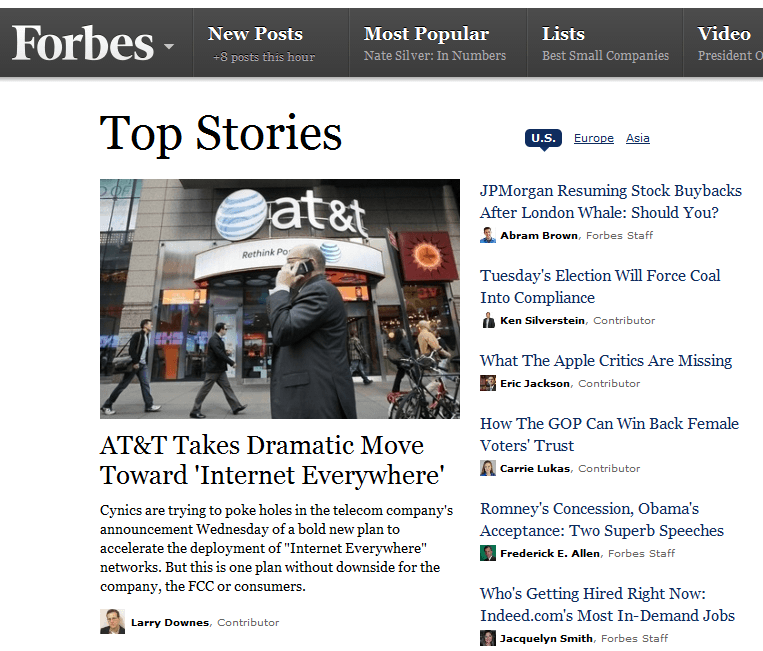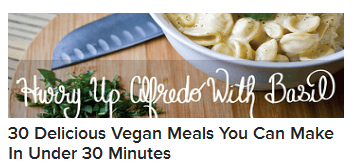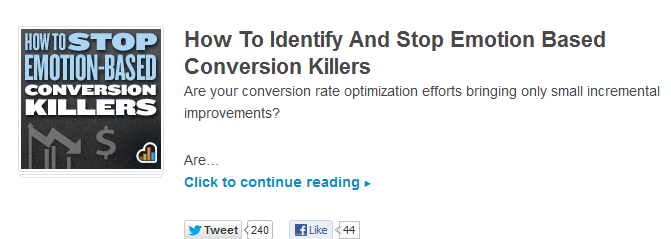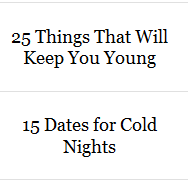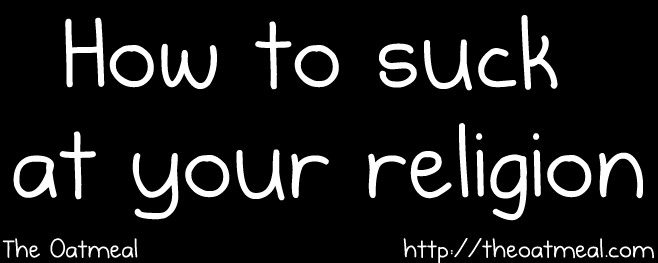While scrolling through my Twitter timeline, I saw a tweet with a link to a BuzzFeed article, the title of which immediately intrigued me: “25 Foods You’ll Never Be Able to Eat Again”. I clicked through, wondering what content awaited me; was it an expose like Food Inc. about the revolting methods of production of certain foods like McDonald’s chicken nuggets, which after reading this I will never be able to stomach? Or was it an article mourning the discontinuation of once-beloved foods?
It turns out it was the latter, BuzzFeed’s commemoration to the death of now-deceased delicacies. The article itself was witty and punchy with the perfect amount of nostalgia, but reading it made me realize the power of a catchy, well-crafted title.
BuzzFeed could have titled this something like 25 Epic Foods That Have Been Discontinued or 25 Foods That We Wish Would Come Back. But, I probably wouldn’t have clicked on this article as eagerly.
Why? Four words (or one acronym, rather): Fear Of Missing Out. Tapping into what’s been affectionately dubbed FOMO is one way to capture attention and get clicks; we don’t like to miss out on things, and we like to know what we’re potentially missing out on. Also 25 Foods You’ll Never Be Able to Eat Again is much more dramatic and exaggerated (but also 100% true) than those other potential titles. And who doesn’t like to indulge in a healthy dose of reminiscence every now and again?
BuzzFeed prompted me to start musing on titles, something that as a blog writer, I come in contact with every day. Titles are make-it-or-break-it kind of things: a brilliant blog post with a lackluster title might not receive the attention it otherwise deserves. It runs the risk of sinking into the digital wasteland of blog oblivion. Similarly, a mediocre post with a shocking title can receive click after click.
According to Copyblogger, on average, 8 out of 10 people will read headline copy, but only 2 out of 10 will read the rest.
As someone not abundantly skilled in the area of headline-crafting copy, this disheartens me, because I struggle with writing a gripping headline. I find it much easier to write a 2,000-word blog post than to develop a cool, catchy, and/or compelling ten-word title.
I once wrote a blog post on Dudepins, a Pinterest site geared for men, which I simply called, “Pinterest for dudes: Dudepins”. (I know, certainly not my finest title.) A week later, Huffington Post published a piece on Dudepins titled “A Pinterest Clone with More Testosterone”. I kicked myself for not coming up with something as ingenious, and then proceeded to praise Huffington Post for thinking of something far more charming and sharper than I ever could.
On the homepage of virtually every major well-known website, we see a lot of titles and very little article content.
Like on Mashable:
Or on Forbes:
It’s these titles that compel us to click. And the promotion of content through social media makes titles more and more relevant. There’s an instinct a lot of us have when we stumble across a brilliant or original piece of writing to share it with others. When we press one of those ubiquitous social sharing buttons, that cookie-cutter tweet or Facebook post we subsequently send out has a very heavy focus on the title. The tweet default actually includes very little text other than the title:

A few months ago, Forbes published a piece entitled “Why Working More than 8 Hours a Day Can Kill You”. These few words virtually guaranteed the piece attention: one, we’re all working eight or more hours a day, so this instills fear and two, the word “kill” (or anything related to death) is jarring and constantly curiosity-provoking. The problem is that this piece cited a study published in the American Journal of Epidemiology that found that spending too long in the office resulted in a 40 to 80 percent greater chance of heart disease compared to an eight hour work day.
Yes, heart disease is the number one killer of Americans, so perhaps working more than eight hours can in theory kill you, but the study found a correlation (see: the post hoc ergo propter hoc logical fallacy), so the title is a bit of a stretch. It’s also obviously and suspiciously sensationalist. There’s an aggravating disconnect between headline and content.
In regards to the art of writing headlines, Brian Clark of Copyblogger articulates it perfectly: “the headline is a promise that your content fulfills”.
I decided to seek out titles that don’t stop at making appealing and tempting promises to readers, but rather carry through on those promises, those titles that compelled me and other people to click and finish reading with satisfaction as opposed to frustration. I wanted to figure out why these titles work and also what they reveal about the desires of readers and the habits of writers.
Get Specific
Why this works: The headline of this BuzzFeed post is ultra-specific; it promises people 30 delicious meals in less than 30 minutes. It also has a subtle sense of empowerment built in “Vegan Meals You Can Make.” A title with specific numbers is far more effective than one with vague terms. Would this post be as intriguing if it simply said “Quick, Delicious Vegan Meals You Can Make”? The time factor is key.
Marketing Experiments conducted a study in which they tested the isolated impact of different headlines on conversion rates of a website. They tested six different headlines:
1. Control
2. Dental Plans for $8.33 a month. Acceptance Guaranteed.
3. Over 55,000 Dental Care Providers. Acceptance Guaranteed.
4. Dental Care Coverage. Best Price Guaranteed.
5. Low Cost Dental Care for the Uninsured.
6. Best Price Dental Care – Without Insurance.
Headlines two and three increased conversion rates the most, with Headline two increasing the conversion rate of the page by 72.76%. The specific dollar-and-cents amount of the plan was much more effective than the imprecise phrase “low cost dental care”.
Posts with Benefits
Why this works: On Copyblogger, Brian Clark talks about the importance of emphasizing benefits, not features, when it comes to writing copy, because it’s the benefits that prompt people’s purchases. This title from the KISSmetrics blog does just that. It tells people exactly what benefit they’ll receive by reading the post: they’ll find out how to both identify and stop emotion-based conversion-rate killers (and, of course, ultimately make more money by increasing conversion rates).
A Pleasant Surprise
HubSpot’s title works because it illuminates sources of content “hiding right under your noise”, so the post itself is akin to a pleasant, unexpected, little surprise. (And research proves that surprises can do wonders in creating loyal customers.)
Lists on Lists on Lists
I think lists will always be appealing, because they offer information in an easily digestible format: written pieces with lists sift through information, condense it, and present it in the form of palatable and unintimidating bite-sized summations.
Unmasking Mistakes
Maybe it’s because almost everyone has a deep-rooted fear of failing or making mistakes, but pointing out errors, blunders, or gaffes in which people might be unwittingly engaging garners attention. Does anyone else have anxiety that mistakes are out there roaming about and masquerading as convincing advice, and you’re unknowingly buying into what you deem to be sound sagacity?
To err is human, sure, but no one wants to mess up, especially if those potential mistakes can be easily avoided. This KISSmetrics title discusses not standard, run-of-the-mill, everyday errors, but critical errors.
Along the same lines, I always find myself clicking on articles that tell people what not to do, like this one from The Oatmeal.
(I’m seeing a vacuum here; perhaps we’re in need of a “How to suck at writing headlines” blog post. Dibs!)
Would I much rather focus on writing a post than writing a title? Yes. But, in our social-sharing-heavy, content-inundated world, devoting time to headline copy is a necessary evil.
Unless you want to pull a Mashable and simply use an enigmatic, nondescript, and rather confusing title (which still received 802 tweets, but I suppose when you’re Mashable, you can probably title something “Untitled” and it will still surpass 99% of other blog posts).



